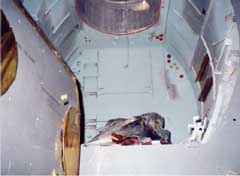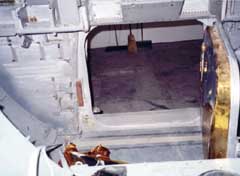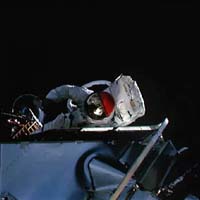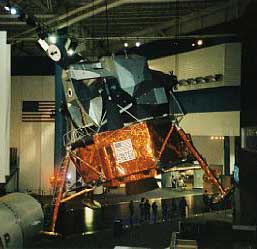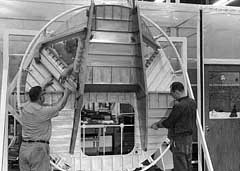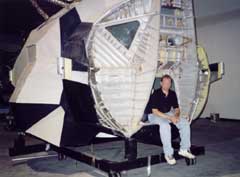lunar module doors







|
|
|
Collier just assumed the astronauts were wearing a space suit and back pack (PLSS) any time they went through the overhead hatch. They weren't; that hatch was only used when the spacecraft were connected to form one continuous shirt-sleeve environment.
In fact, the PLSSes were actually stored in the lunar module until they were needed on the lunar surface. You don't need a PLSS every time you wear a space suit. You can plug your hoses into the spacecraft's oxygen supply if you aren't going outside. The PLSS is only for when you're outside the spacecraft. To prepare for an actual landing, the astronauts could put on their space suit (minus helmets and gloves) in the command module, go through the connecting tunnel to the lunar module, and complete the suit-up and pressurization there.
On some of the longer missions the astronauts performed a "stand-up EVA" shortly after landing on the moon. To do this, they connected the suits to the LM's oxygen supply, opened the overhead hatch, and stood on the ascent engine cover to poke their head and shoulders out of the top of the spacecraft. They were able to get a good view of the landing site and its surroundings from there. But it wasn't until they planned to leave the spacecraft altogether that they needed the PLSS. Then they would go out the forward hatch, which was bigger.
 Semi-official sources
reveal that the lunar module's forward hatch actually opened
inward. This would have prevented the astronauts from
egressing the spacecraft as claimed. [James Collier]
Semi-official sources
reveal that the lunar module's forward hatch actually opened
inward. This would have prevented the astronauts from
egressing the spacecraft as claimed. [James Collier]
|
"An overlooked fact of the lunar module design," it says, "was that the door opened inward and to the right." Collier interprets this to mean that Grumman mistakenly had the door open inward -- i.e., that they and NASA were the ones overlooking the obvious problem with that. But a better interpretation is that the general public tends to overlook this. The engineers knew what they were doing.
It's far safer, when designing a pressure vessel such as a spacecraft cabin, to have the doors open inward rather than outward. If door opens inward, the air pressure inside keeps it closed by seating it firmly against the edges of the opening. This will be the case even if the door latch fails. But if the door is on the outside of the opening and opens outward, the only thing holding it closed against the interior pressure would be the latch.
 NASA did not provide the
astronauts with any instruction manual for getting out of the LM
around that inward-opening door. [James Collier]
NASA did not provide the
astronauts with any instruction manual for getting out of the LM
around that inward-opening door. [James Collier]
|
Of course there was a general procedure. But it was left to each crew to work out the details. (The crews themselves wrote or helped to write many of the formal procedures and checklists. The assumption that everything the astronauts did was worked out by someone else is fairly naive.)
The forward hatch occupied the middle segment of the front wall of the cabin (Fig. 2), beneath the center instrument panel. The commander normally stood to its left and the lunar module pilot (LMP) stood to the right. After donning their suits and PLSSes, the pressure was bled away into space and the LMP opened the door. It was hinged on his side, so he had to crowd toward his side of the cabin and hold the door open against his legs. The commander would then turn round, get down on his hands and knees, and back out onto the porch. After he had gone down the ladder, the LMP could close the door, move to the commander's side of the cabin, open the door again, and repeat the commander's procedure.
The ingress procedure was the reverse. The LMP entered first on hands and knees, stood up and closed the door so that he could move to his side of the cabin, then held the door open for the commander. After the commander was in and standing, the door could be sealed and the cabin again filled with oxygen.
Mission planners found there was little need to formalize anything about this procedure, nor to write down in detail whose hand and foot would go where at what time. The problems that arose were usually too ephemeral and specific to merit putting them in a written procedure. It was simply better for the two individuals to work out the details in whatever way seemed logical to them and guide each other in and out of the hatch. The astronauts were not merely obedient slaves. They were intelligent, innovative, integral parts of the mission planning process.
 James Collier measured
an actual lunar module forward hatch and found it to be only 32 inches
wide. This is too narrow for a space-suited astronaut to pass
through.
James Collier measured
an actual lunar module forward hatch and found it to be only 32 inches
wide. This is too narrow for a space-suited astronaut to pass
through.
|
Collier's choice of mockup turned out to be fortuitous. Not only is LTA-8A's forward hatch the right size, one of LTA-8A's jobs in Houston was to train astronauts for ingress and egress. To do this, the entire mockup was placed in a vacuum chamber. Astronauts donned space suits and backpacks and practiced going in and out of the hatch. Apollo 15 astronaut Jim Irwin recalled his training on LTA-8A:
"I'm wondering if we ever did any ingress training at one-sixth g. I don't think we did[1]. I was just surprised that I had such difficulty [with LM egress and ingress on the moon], because I'd done a lot of practice in one g with the backpack on because, originally, in the LTA-8 tests -- for the thermal vacuum chamber -- they were going to use the PLSS under one-g conditions. You know, climb the ladder and go through the hatch, just like we do on the Moon. I'd done that several times and had no difficulty. But you wouldn't have any difficulty in one g because the weight of the PLSS on your back [is] so great and the suit, itself, (also) compresses." (Comments to Eric Jones, ALSJ)NASA retirees inform us that these vacuum chamber tests involved many people working around the clock in three shifts. There are ample witnesses to the ability of an astronaut to get through the forward hatch of LTA-8A fully suited.
Astronauts aren't the only people who participated in LM egress/ingress testing. Grumman engineers fine-tuned their LM design in their own vacuum chambers using space-suited volunteers. Simply too many people saw space-suited astronauts go in and out of the LM forward hatch for there to be any credibility to the claim that it was too small.
|
|
Bear in mind that Collier never actually tried to fit a space suit through the hatch. He relied strictly on tape measurements both of the hatch and of the suit.
Mary Bennett and David Percy (Dark Moon, p. 341) make the same argument. They didn't test-fit a suit either. They used only tape measurements, just as Collier did. Based on their measurements they say egress would be "very difficult" and "rather a challenge." Then a paragraph later -- without providing any additional evidence -- they call the task "clearly impossible."
 But several people have
measured the space suits and found them to be 32 or so inches
wide. How could that fit through a 32-inch door?
But several people have
measured the space suits and found them to be 32 or so inches
wide. How could that fit through a 32-inch door?
Sometimes readers misinterpret this to mean the PLSS is too wide. According to drawings we obtained from Hamilton-Standard, the company that designed it, the PLSS was only 19 inches wide. Frank O'Brien, a restorer at the Cradle of Aviation Museum, measured a Beta-cloth PLSS cover in their collection; it's 20 inches wide -- just about right to fit over a 19-inch PLSS. That easily fits through a 32-inch opening.
The conspiracist authors chiefly refer to the width of the suit itself. They're careful to remind you that the suit is deflated for their measurements; an inflated suit must be larger. The conspiracists don't tell you about the restraint layer that keeps the suit from bulging uncontrollably.
First, clothes without anyone in them tend to be wider -- not narrower -- than occupied clothes. This is a straightforward matter of geometry: when a fabric envelope is collapsed along one dimension, it broadens along the other. The conspiracists always measure empty space suits.
They measure the suits at the widest point. That's quite defensible if you want to see whether something will fit through an opening. But the widest point in these photographs is a width that doesn't really exist when the suit is being worn and when the astronaut is on his hands and knees backing out of a spacecraft. The suit arms in the conspiracist photos (e.g., Dark Moon, p. 341f, photos 8, 9) hang from the shoulders as you would expect such a garment to do while not being worn. This makes the elbows stick out to either side. And the conspiracists measure from elbow to elbow -- about 32 inches. That dimension includes the width of the suit torso plus the width of each of the sleeves.
But an astronaut on his hands and knees places his arms in front of his face. Backing out of the hatch this way, his torso passes through the hatch first and then his arms, so measuring them together is wrong. The Apollo LM egress posture makes an astronaut's shoulders the widest point. Looking at the photo provided by Bennett and Percy (ibid., photo 8) showing a tape measure laid across an Apollo suit, we see that the width of the shoulders (as determined by the shoulder seams) is about 22 inches.
In Fig. A we show an adolescent's ski parka hung on a hanger and measured in the conspiracists have used to measure space suits. The width, from elbow to elbow, is XXX inches. As you can see, this grossly exaggerates the working width of the garment. This is how the conspiracists make the suit seem wider than it really is.
We also note that 32 inches is the standard width of an interior door in American residences. This should give readers some practical understanding of the LM forward hatch dimensions.
As Jim Irwin recounts above, the difficulty was not squeezing the width of the suit through the hatch; it was the height. The PLSS is 8 inches thick and the forward hatch 32 inches tall, leaving 24 inches for the astronaut and his inflated space suit. As Figures 1 and 2 show, the short distance between the hatch and the "shelf" for the ascent engine cover meant the astronaut had get at least his legs out of the hatch before he could assume a more prone position. The bottom of the PLSS habitually hung up on the top lip of the hatch, or the astronaut's suit snagged on something on the floor. In the practice sessions in LTA-8A the astronaut was in full earth gravity, which compressed his suit slightly more than it did on the moon. This is why Irwin had more trouble than he imagined.
Conspiracists aim to convince their readers that LM ingress and egress were impossible. But they can do no more than show it was difficult. We agree it was difficult. As with all difficult things in astronautics -- and there are many -- the key is practice. The conspiracists attempt no actual trials nor do they see if egress is something that improves with patience and repetition. They simply make one pass with the tape measure and declare it to be impossible.
 But author Ralph Rene
did an actual experiment. He used his dining room table to
approximate the lunar module hatch, and he loaded himself down with
the same volume as an Apollo suit. He couldn't fit under the
table.
But author Ralph Rene
did an actual experiment. He used his dining room table to
approximate the lunar module hatch, and he loaded himself down with
the same volume as an Apollo suit. He couldn't fit under the
table.
And this proves only that Ralph Rene can't fit under his dining room table. It does not answer whether Apollo astronauts could fit through the LM forward hatch. That was demonstrated many times in vacuum chambers in front of many witnesses.
 Why do some sources say
that the hatch is 42 inches wide instead of 32 inches? Is NASA trying
to correct its previous errors? [Bennett and Percy, op. cit.,
p. 341]
Why do some sources say
that the hatch is 42 inches wide instead of 32 inches? Is NASA trying
to correct its previous errors? [Bennett and Percy, op. cit.,
p. 341]
The authors do not specify which sources say this, nor whether they are NASA or third party sources.
We are aware of only one source -- the New York Times -- that has reported the size of the LM forward hatch as 42 inches. And this is the source that was cited at the Apollo Lunar Surface Journal until its author was made aware of the Times' error. All the period sources we've seen from NASA and Grumman (e.g., the Apollo 11 press kit, the Apollo News Reference, and the Lunar Module Operations Handbook) give the dimensions of the lunar module forward hatch as "approximately 32 inches square."
Clavius thanks Frank O'Brien who contributed to this report.
NOTES
- One-sixth g training was done on the "Vomit Comet", the same aircraft used for weightlessness training. To simulate one-sixth g, the aircraft flew a shallower parabola. Because the lesser gravity lasted only 30 seconds or so, lengthy or complicated procedures couldn't be effectively rehearsed that way.
